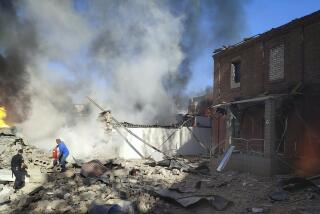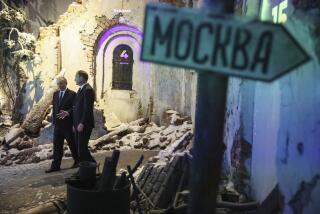Atom Plants: Real Hazards During War
- Share via
MOSCOW — Higher-than-admissible readings of soil contamination with long-living radionuclides (cesium, strontium, plutonium) are now being registered mostly on the territory of the Chernobyl power station and in the 5-kilometer zone around it, as well as in several pockets in the territory of Byelorussia. There are no grounds for expecting any radical changes in the current radiation situation, since flooding that would spread the radioactive soil has not materialized to any degree.
Analysis of the radiation consequences for the population that was subjected to contamination as a result of the Chernobyl disaster indicates that dosages of external gamma and beta radiation exposure in 1986 were lower than the maximum yearly dose set in the radiation safety norms adopted in 1976.
Over the next 50 years the dosage from the natural background radiation will end up 15 times higher than the corresponding cumulative dosage from the Chernobyl disaster.
In this context the increase in the number of fatal cancer cases will be less than 0.05% of the spontaneous cancer mortality rate.
Tentative assessments of the contamination of food products by the main biologically important radionuclide, cesium-137, show that the probable increase in the cancer mortality rate caused by that factor will not exceed 0.4% of the number of natural deaths from malignant tumors.
As for the regions that lie hundreds, let alone thousands, of kilometers from Chernobyl, given all the objective data, there are absolutely no grounds for the predictions of a surge in the incidence of cancer in the next few years; speculation about 50,000 more deaths in Europe must be dismissed as groundless.
The Chernobyl experience does show something new: In the case of an armed conflict in Europe, all atomic-power stations would become extremely dangerous additional radiation hazards--in terms of both external and internal exposure of people. The events at Chernobyl graphically demonstrated what would happen if nuclear weapons were brought into play.
The explosion of a nuclear weapon on hitting a nuclear reactor would be incomparably more dangerous than an ordinary explosion. In that case the ground would be contaminated with long-living radioactive particles. This is explained by the fact that the majority of radionuclides in the reactor are formed as a result of extended operation. Thus the share of short-living radionuclides released with the destruction of the reactor would be much lower than their share in the mixture of radionuclides that form as a result of a nuclear explosion. But the share of long-living radionuclides would be much larger.
In the case of a nuclear war in Europe, which would certainly cause the destruction of most atomic-power stations and nuclear processing plants, a large part of the Continent would be contaminated not only with the products of nuclear explosions but also with long-living products of nuclear reaction and with nuclear fuel elements.
This would sharply extend the period of radioactive decline, as compared to the decontamination process after a nuclear explosion alone.
From the viewpoint of population safety, the increase in the period of radioactive decline would necessitate a longer stay in shelters and a longer use of individual protective means with all the ensuing consequences.
The difficulty in protecting the population is further compounded by the specific factors involved in each particular situation. This is because the volume and isotope composition of the radioactive debris scattered by the explosion depend on the character of the destruction, average intensity of fuel combustion in the reactor, the fuel reloading schedule and the time since the last reloading, the character of the emission and many other factors. The area of contamination in the case of a damaged or destroyed reactor is variable, too. Since the radioactive cloud after the destruction of the reactor would rise to a relatively low altitude (several hundred meters, compared to kilometers in the case of a nuclear explosion), the radioactive fission products carried by it would settle on the ground within a comparatively short period.
As Mikhail S. Gorbachev stressed in May of last year, Chernobyl is one more stern warning and reminder that the nuclear age demands new political thinking.
Some military experts estimate that only one medium-range missile is equal to 100 Chernobyls. In nuclear arsenals of both sides there are a lot of medium-range missiles, as well as much more powerful strategic weapons.
So one of the lessons of Chernobyl is that we should make all possible efforts to reduce the nuclear arsenals of both sides to zero.
More to Read
Sign up for Essential California
The most important California stories and recommendations in your inbox every morning.
You may occasionally receive promotional content from the Los Angeles Times.










